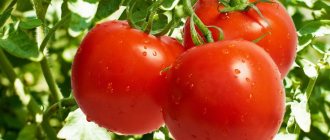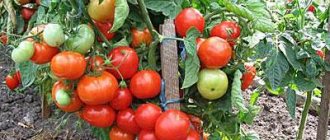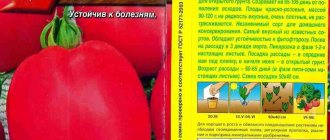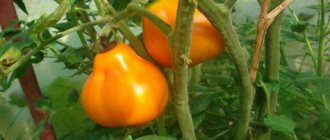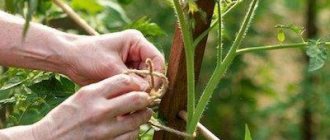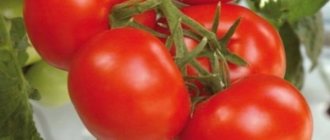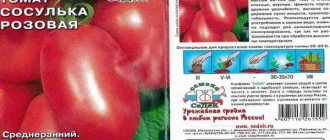Author's rating
Author of the article
Yakov Pavlovich
Professor, Head of the Department of Vegetable Growing
Articles written
153
When buying tomato seeds at a garden store, gardeners often come across the word “beef” on the bag. What are these “beef tomatoes” and how are they different from the usual varieties? This marking of seed material is common in the USA and Europe. The fruits are consumed fresh, baked and fried along with grilled meat.
Description and characteristics
The indeterminate hybrid Big Beef f1 was developed by the Dutch company Monsanto for cultivation in greenhouses and greenhouses. It was included in the State Register of Russia in 2008.
Plants are spreading, powerful, with a lot of leaves.
In the photo there is a bush of tomatoes Beef Big f1.
Distinctive characteristics table.
| Indicators | Characteristic |
| Weight | 200-250 g |
| Form | Flat-round, slightly ribbed. |
| Coloring | Red. |
| Leaves | Large, light green. |
| Type of inflorescences | Simple. |
| Number of slots | More than six. |
| Number of cameras | Six or more. |
| Pulp | Meaty, juicy. |
| Taste | Sweet, pleasant. |
| Skin | Smooth, dense. |
| Purpose | For fresh consumption, canning, making juice and paste. |
| Bush height | 1.8-2 m |
| Ripening period | 99-105 from the moment of emergence. |
| Productivity | 9.4 kg/m² |
| Sustainability | To low temperatures, root-knot nematode, fusarium, verticillium, TMV. |
| Transportability | High. |
Tomato Big Beef F1. AgroElita
The best varieties and their descriptions
Domestic gardeners successfully grow not only foreign varieties of large-fruited tomatoes, but also plants of Russian selection. Hybrids bred in Russia are more unpretentious to growing conditions.
Yummy beef f1
A hybrid variety of large-fruited tomato with red skin. The plant is formed into a single stem, which reaches a height of 170 cm. The harvest is formed in clusters, 5-6 fruits each, weighing from 230 g (individual tomatoes can weigh 400 g!).
The fruit is round, slightly flattened, with slight ribbing. There is a tiny nose visible at the top of the tomato. The interior is multi-chambered, low-juicy. The pulp is sugary, dense, tasty.
The hybrid is recommended for growing in open and protected ground. The yield in a greenhouse can reach 18 kg per 1 sq. m.
Mona beef f1
Medium-early tall hybrid for film and polycarbonate greenhouses. The first fruits ripen 98–100 days after the sprouts appear. The height of the bush reaches 170 cm.
See also How to grow and care for a tomato tree
The weight of tomatoes exceeds half a kilo, and specimens weighing 700 g are not uncommon. Due to the large weight of the fruits, it is recommended to leave no more than 3 of them in a cluster, and additionally tie the clusters to a trellis.
The color of the skin and pulp is dark red. The taste is sweet, rich. The pulp is dense.
The yield of tomatoes per plant is 5–6 kg.
Big sasher
A hybrid of tall tomato with relatively small fruits, weighing 150 g. The harvest ripens 95 days after germination or 100 days after planting. Stem height up to 270 cm. It is recommended to grow indoors.
The fruits are round and regular in shape. The skin is dark brown, durable. The taste is sweet, the flesh is dense.
Beef porter f1
Large-fruited hybrid f1 of medium ripening period. The height of the plant does not exceed 1 m, which makes it suitable for growing in open ground.
The fruits are round, slightly ribbed, and impressive in size – some weigh more than 1.5 kg. The usual weight of a tomato is 700–1000 g. The skin color is red, the flesh is tender, sweet and sour.
Beef master
Dutch hybrid from the group of beefsteak tomatoes. The stem rises to a height of 170–190 cm, up to 9 clusters are formed on it, each containing 4–5 tomatoes. The harvest begins 110 days after germination.
The fruits are red, round. Their weight ranges between 250 and 800 g, with an average weight of 400–500 g. The pulp is sweet and dense, with a small number of seeds.
Expert opinion
Stanislav Pavlovich
Gardener with 17 years of experience and our expert
Ask a Question
The hybrid is suitable for growing in greenhouses and open ground (in the southern regions). The plant tolerates heat well, the fruits do not crack. Productivity up to 16 kg per 1 sq. m in a greenhouse.
Negro beef
A hybrid for salad purposes, with a tomato weight of 300 g. The plant grows up to 250 cm, so gartering to a trellis is required. Recommended for placement in greenhouses and greenhouses in the middle zone and in open ground in the south.
Tomatoes are round in shape, beautiful chocolate in color. The pulp is very sweet, sugary, aromatic. Up to 7 kg of fruits are removed from the bush.
Big Tasty f1
The hybrid forms a bush, 180–200 cm high. The plant can be planted in greenhouses and outdoors, tied to a trellis. The harvest ripens 120 days after sowing.
Expert opinion
Stanislav Pavlovich
Gardener with 17 years of experience and our expert
Ask a Question
The fruits are red, flat-round, with slight ribbing, weighing 220–300 g. The pulp is tender, juicy, and sweet.
Advantages and disadvantages
Advantages of a hybrid:
- earlier maturation;
- Possibility of ripening in a cool room;
- excellent transportability;
- pleasant taste due to the large amount of sucrose;
- dense skin does not crack;
- long shelf life;
- resistance to nightshade diseases and low temperatures.
Among the disadvantages are the need for pinching to form a bush into one stem and garters.
What are beef tomatoes?
There are many varieties of tomatoes. Fruit size is the main characteristic of any variety. On its basis, a classification has been created according to which all tomatoes are divided into three groups:
- The first includes small-fruited varieties, including cherry tomatoes. Their fruit weight does not exceed 70 g.
- The second group includes tomatoes with medium-sized fruits. Their weight is more than 70 g, but does not exceed 100 g.
- The third category includes all varieties of tomatoes with a tomato weight of more than 100 g. This is the variety of beef tomatoes.
The first varieties were developed by a farmer from America, Johan Munstr. The flesh of his tomatoes was very meaty, so he called them beef (beefsteak), which means meat. Beefs are productive F1 hybrids. Large fleshy fruits can weigh from 150 to 1500 g.
General description of beef tomato fruit:
- shelf life is about 7 days;
- poor transportability;
- thin skin;
- tasty, dense, fleshy pulp;
- beautiful cut;
- multi-chamber.
Hybrids are resistant to fungi and viruses; no chemicals are used in their cultivation.
Growing seedlings
Sowing work begins in late February-early March, 55-60 days before planting in the ground. Pre-prepare containers and soil.
Soil preparation and sowing
Hybrid seeds do not need to be treated with anything; the manufacturer has taken care of this.
For sowing, universal soil for seedlings or prepared by yourself is suitable . To do this take:
- 1 part peat;
- 1 part humus;
- 1 part turf;
- 1 part river sand;
- 1 tbsp. l. wood ash;
- 1 tbsp. l. superphosphate.
It is advisable to disinfect the soil by heating it in the oven or watering it with a solution of potassium permanganate. Next, the substrate is moistened and filled into containers 5-7 cm high with drainage holes at the bottom to drain excess water.
Make grooves 1.5 cm deep in the soil and lay out the seeds at intervals of 2 cm . Sprinkle a 1 cm layer of soil on top, water with a syringe and cover with polyethylene. The containers are placed in a dark place, the film is removed daily for 15-20 minutes for ventilation. Shoots appear at a temperature of +22 °C after five days, at 25 °C after three days.
For sowing seeds, a method that does not involve picking is often used . To do this, take special thick bags from gardening stores or tall plastic glasses. Fill the containers with soil and lay out two seeds. Cover with film and wait for shoots.
Seedling care
When sowing seeds in general containers, the sprouts are planted in peat cups or other containers after 4-5 true leaves appear. The seedlings are placed on a windowsill with sufficient lighting.
If the seed was immediately sown in separate glasses , the strongest one is selected from the two sprouts that appear, and the weak one is removed. The soil is replenished as the seedlings grow.
The optimal temperature for the growth of strong seedlings is +20 °C during the day, and +15 °C at night . If there is not enough light, install phytolamps. The longer the daylight hours, the better - the seedlings do not stretch out and gain strength faster.
The soil is moistened moderately using a syringe or syringe, pouring water under the root.
Before planting in the ground, tomatoes are hardened . Every day, the seedlings are taken out into fresh air and left for two hours. The time is gradually increased to 24 hours.
About other varieties of large-fruited tomatoes:
Why is the Beef Pink Brandy F1 tomato so good?
Large-fruited sweet tomatoes “Pink Giant”
Big Beef tomatoes on video
If you grew Big Beef F1 tomatoes, please write whether you liked them or not. What was the yield and taste of the fruit under your conditions? Would you grow them again and recommend them to others? If possible, attach a photo of the entire bush or individual fruits you grew to your comment. Thank you!
Your reviews of the Big Beef tomato and additions to the description will help many gardeners in an objective assessment of this hybrid.
Tomato Beef Master is an ideal choice for those who love sweet and meaty tomatoes. The sugary pulp when cut resembles a watermelon. Gives rich harvests and at the same time is unpretentious in care. Recommended for film and glazed greenhouses, in the south - for open beds.
| Height | Landing location | Ripening time | Fruit color | Fruit size | Origin | Fruit shape |
| Tall | Greenhouse, Open ground | Mid-season | Reds | Large | Hybrid | Flat-round |
Agricultural technology of tomatoes
Hybrid Big Beef grows best in loamy or sandy loam, breathable soil . Tomatoes need constant care: pinching, watering, fertilizing, preventing diseases and pests.
Landing in the ground
Before “relocating” tomato seedlings to a permanent place , they prepare the soil in the greenhouse.
The top layer is removed (5-10 cm), the remaining soil is disinfected with copper sulfate (1 tbsp per 10 liters of water). Next, the soil is loosened, the weeds are struck and 6 kg of humus per 1 m² is added. Planting is done in cloudy weather or after sunset . Optimum soil temperature +12 °C +15 °C. Remember that tomatoes cannot be planted in cold soil. The roots do not develop and rot, which negatively affects the growth of the crop. Holes for seedlings are dug to a depth of 10-15 cm and filled with boiling water or a hot dark pink solution of potassium permanganate. The seedlings are carefully examined and the lower leaves are removed.
Advice. The ideal place for planting tomatoes is soil in which legumes, cabbage, carrots or beets were previously grown.
The distance between seedlings should not exceed 30 cm, between rows - 70 cm . The plants are watered abundantly and immediately tied into supports.
Watering and care
To water the plants, use warm, settled water and follow the:
- before the flowers appear - once a week (5 l);
- during flowering - every three days (3 l);
- when tomatoes appear - once every seven days.
After watering, the soil is loosened, the greenhouse is ventilated, but drafts are not allowed.
During the growing season of plants, fertilizing is applied 3-4 times, following the following scheme:
- For the first time, prepare a solution of mullein in a ratio of 1:10, add nitrogen. This is necessary for intensive leaf growth.
- The second portion of fertilizer is applied after 14-20 days. For 10 liters of water take 20 g of potassium salt and superphosphate. Potassium-phosphorus fertilizers stimulate metabolism and improve the taste of tomatoes.
- During the flowering period, fertilize with boric acid (take 2 g of substance per 2 liters of water). The leaves are irrigated with a solution to accelerate the formation of ovaries.
- During fruiting, potassium-phosphorus fertilizer is re-applied.
Big Beef is formed into one stem by weekly pinching the stepsons growing from the leaf axils. Such manipulations allow you to obtain a bountiful harvest and prevent overcrowding. 7-8 brushes are left on the bushes, the tops are tied to supports.
Features of planting and care
Large-fruited tomatoes are more capricious to grow than ordinary varieties. Most beef tomatoes are tall, so staking with stakes or a trellis is required. To obtain a stable harvest, plants are grown in a greenhouse, providing them with regular watering and fertilizing.
Growing by seeds
Plants for planting in a greenhouse are sown in February - early March for seedlings. Store-bought hybrid seeds are already treated for disease and are often coated with fertilizer. They do not require additional processing.
Dry seeds are lowered to a depth of 7–9 mm, placing 1 seed in a separate pot with a volume of 250–300 ml. The substrate for tomatoes should consist of humus, peat, sand and garden soil, taken in equal parts.
Important! When making the mixture yourself, you need to disinfect it. The soil is steamed or spilled with “Fitosporin”, a solution of potassium permanganate.
The seedlings are kept in a bright room, maintaining a temperature of +18 degrees at night and +23 degrees during the day. Water the tomatoes sparingly with warm water.
See also How to plant and grow tomatoes on the balcony: the best varieties and step-by-step instructions
At the age of 3–4 true leaves, the seedlings are transplanted into pots with a capacity of 1 liter. After transplantation, the tomatoes are fed with complete mineral fertilizer (Kemira, Agricola, Gera).
Expert opinion
Stanislav Pavlovich
Gardener with 17 years of experience and our expert
Ask a Question
Seedlings are planted in a permanent place at the age of 55–60 days. The plants are watered abundantly beforehand. The layout of beef tomatoes is 60 by 70 cm. The surface of the ground after planting is mulched with sawdust, grass or tree bark, in a layer of 10 cm. Mulch protects the soil from drying out and overheating, and suppresses the development of weeds.
How to care for such tomatoes
Beefsteak tomatoes are formed into 1-2 stems, tying the plant to a strong trellis. A tomato develops at a temperature of +20...+25 degrees; at low temperatures, plant growth stops; at high temperatures, the pollen becomes sterile.
Tall tomatoes require watering and fertilizing. During the growth of tops, flowering and fruiting, the bushes are watered every 3–4 days, spending 10–15 liters per plant. From the moment the tomatoes turn red, watering is reduced to once a week.
The “beefs” are fed every 3 weeks, starting from the moment of picking. Use mineral fertilizers with a predominance of potassium (potassium sulfate, Agricola, Good Power).
To obtain very large specimens of fruit, the ovaries are normalized. No more than 3 (usually 1–2) tomatoes are left on each bunch, the rest are removed. All lower leaves are also removed from the stem so that the bushes are better ventilated.
Expert opinion
Stanislav Pavlovich
Gardener with 17 years of experience and our expert
Ask a Question
Advice. To prevent the bases of the hands from breaking under the weight of the fruit, they are additionally tied up.
Harvesting is carried out weekly.
Productivity and use of fruits
In greenhouse conditions, up to 18 kg of tomatoes are harvested from each square meter. In open ground the result is more modest - about 9 kg.
Beef tomatoes are eaten fresh, placed on sandwiches and made into salads with sweet fruits. The meatiness of “beefs” allows them to be used in the preparation of vegetable stews and sauces. When fried and stewed, tomato pieces yield little juice.
Prevention of diseases and pests
The Dutch hybrid is immune to fusaoria, verticillium, cladosporiosis and tobacco mosaic virus (TMV) . But it is not always possible to protect tomatoes from late blight. This is all due to non-compliance with the rules of agricultural technology: excessive watering, high humidity in the greenhouse, excess nitrogen in the soil.
The disease can be recognized by these signs:
- brown spots on leaves, fruits and stems;
- whitish edge on the back of the leaf;
- deformation of tomatoes.
Proper care and preventative measures can prevent infection . To do this, in the fall, greenhouses are disinfected using sulfur bombs, and after planting the seedlings, the soil is mulched with sawdust, and the soil is disinfected with copper sulfate.
Help fight late blight :
- microbiological preparations “Fitosporin”, “Trichodermin”;
- chemicals “Bravo”, “Ditan”, “Ridomil Gold”.
Folk remedies work no less effectively:
- ash (pour 300 g into 1.5 liters, bring to a boil, strain through cheesecloth, bring the volume to 10 liters and add 20 g of soap shavings);
- hay (1 kg of rotten raw materials and a handful of urea are soaked in 10 liters of water for 3 days);
- copper sulfate (2 g of substance, 200 g of soap shavings added to 10 liters of water).
Tomatoes attract insect pests : aphids, mole crickets, whiteflies, spider mites, and slugs.
Flumite, Borneo, and Fitoverm products will help get rid of aphids, mites, and whiteflies. Products based on onion peels, garlic, ash, and tobacco are highly effective.
Recipes for folk remedies:
- 400 g of chopped garlic, pour 1 liter of water, leave for 5 days;
- Pour 300-400 g of tobacco shag into 10 liters of boiling water, leave for two days;
- Grate 100 g of tar soap and dissolve in 10 liters of water;
- chop a bunch of celandine, pour in 5 liters of warm water, strain after 24 hours and bring the volume to 10 liters;
- Pour 50 g of ash, 25 ml of liquid soap into 10 liters of water and mix.
Slugs are collected manually or the plants are treated with a solution of ammonia (2 tablespoons of ammonia per 5 liters of settled water).
Reviews from gardeners
Beef tomatoes require constant care, so not all gardeners, especially beginners, dare to grow them . But those who have already tried it are satisfied with the result.
Anna, Davydovka village, Voronezh region. : “I’ve been eyeing this Dutch miracle for a long time and last year I decided to plant several bushes in the greenhouse. The germination of the seeds is excellent, the sprouts hatched after 4 days. Fruiting is abundant, the tomatoes are large, juicy and aromatic. I once tried to grow it in open ground, but unfortunately, it didn’t work out. The summer turned out to be rainy and cold. The bushes were affected by late blight and had to be dug up and burned.”
Victor, Gukovo, Rostov region. : “I have been growing Big Beef for four years in a row for my own consumption. The bushes are tall, reaching 2 m in a greenhouse, and require staking. The fruits are large, the pulp is fleshy and very sweet. The maximum weight reached 700 g. Tomatoes are delicious fresh; we also prepare sauces and juice from them.”
Natalya, Bolshoye Kozino village, Nizhny Novgorod region. : “Big Beef is one of the favorites in my area. With proper care, fruiting continues until frost. Tomatoes can be picked at the stage of technical ripeness, and they will ripen quietly in foam trays.”
Characteristics of beef tomatoes
There is no clear classification of tomatoes by fruit size, at least not yet. This is probably due to the fact that the size of the tomato is variable.
Do you like beef tomatoes?
Yes
91.67%
No
8.33%
They become smaller when grown on saline soils, excessive fertilizing, lack of pinching and fruit rationing. Increase in size is facilitated by:
- timely and correct formation of bushes;
- control over the load of tomatoes with fruits;
- moderate, competent feeding of tomatoes with a predominance of phosphorus and a minimum of nitrogen;
- favorable weather - warm, but not hot (more than 30° C), without temperature changes;
- attracting bees to the site during flowering;
- high groundwater level or frequent watering.
Definition of beef tomatoes
What beef tomatoes are, different seed companies interpret in their own way. Usually, a larger or smaller limit mass is indicated so that as many of their varieties as possible can be called beefsteak.
The generally accepted criteria indicating that tomatoes belong to the beef category are as follows:
- fetal weight – 150 g or more;
- the volume of the middle pulp is larger than the seed chambers and their contents;
- nests – at least 4;
- the pulp is fleshy, often with a granular structure;
- the content of dry matter and sugar is higher than in other varieties;
- the surface is usually slightly ribbed, less often smooth;
- a small number of flowers (compared to other varieties);
- the shape of the tomatoes is flat or round;
- the skin is often thin, which reduces transportability and keeping quality, but hybrids with strong, dense covers have already appeared.
Beef tomatoes contain 2-3 times more useful substances than ordinary varieties. This is due to the fact that large fruits take longer to ripen. Consequently, they have more time to accumulate vitamins, pectins, monosaccharides, and microelements.
The color of the fruit can be any. Red beef tomatoes produce thick juice, which is suitable for preparing first courses. Pressed yellow and pink tomatoes have very little acid. They are rarely used for borscht, and the jars are regularly inspected for bloating.
Among the beef there are both varieties and hybrids. They can be early, medium or late ripening.
What you need to know when caring for beef tomatoes
Beef tomatoes, according to gardeners, always produce a large harvest. But in order for them to live up to their name and not turn into mediocre varieties, they need good care. This means you should:
- choose high-quality, full-bodied seeds;
- discard weak seedlings;
- per 1 sq. Plant 2-3 m in open ground, 1-2 tomatoes in a greenhouse;
- bushes must be formed, leaving 1, rarely 2, shoots;
- tie the tomatoes to a strong support;
- if many ovaries have formed, normalize, leaving no more than 4 fruits on each cluster;
- feed throughout the entire growing season with a complete mineral complex, first with a predominance of nitrogen, then phosphorus and potassium;
- spray the above-ground part with water-soluble fertilizers, chelates, anti-stress drugs, additional doses of magnesium, boron;
- Water beef tomatoes more often than regular varieties, but this does not mean that they should be drowned in water or allowed to stagnate in the root area.
